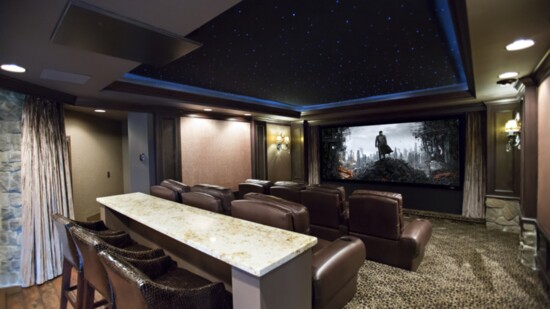There is something magical about walking into a theater for a movie. It is an experience unlike almost any other: losing oneself to the darkness, feeling the bass in your chest. The world fades away for 90 minutes, and maybe that’s part of the charm. But what if you could create that experience in your own home?
Home theaters are becoming more and more of a reality for many as it becomes easier to find and stream high-quality films, and the costs of the equipment necessary to recreate that theater experience in your own home are within reach.
Brian Duggan, co-owner of Union Place, is no stranger to both the movie-going experience and home theaters. “I live, eat, and breathe these things,” says Brian, and here, he offers us a tour through the “ultimate” home theater.
The ultimate home theater is a “dedicated room with a projection system primarily used for watching sports or TV,” says Brian. While many spaces, including some home theaters, are designed with many purposes in mind, to Brian, the ultimate home theater is a space entirely dedicated to the TV-watching experience.
To that end, the projector and screen are the most essential parts of any home theater. Union Place’s screens start at around 110 inches and go up to 220 inches. Those sizes are way up even from a few decades ago when sub-100-inch screens were standard.
Depending on the size of the screen, projectors need to be able to shoot 4k to 8k resolution, which is pretty common and available even for new films. 4k streaming is often available soon after a movie is released and is perfect for a home theater. “You can catch a movie in your home theater while it’s still relevant,” says Brian. Projectors can average anywhere from $5,000-$20,000 but can go for much less or much, much more, and that is what’s most likely to get replaced in a theater due to time or technological processes. “You’re dating your projector; you’re married to your screen,” says Brian.
Speakers are the next most important part of the ultimate home theater. Beyond the mere scope of a theater, the sound quality is the biggest difference between watching something at home versus in a theater. True surround sound with a bass you can truly feel is what separates the wheat from the chaff. In times gone by, a standard setup for a home theater would be what’s called 5.1. That means five speakers would be set up around the room to provide surround sound with a single subwoofer. These days, the ultimate home theater would be something closer to 13.4.4. That means there would be 13 speakers scattered around the room, 4 subwoofers, and 4 ‘atmo’ or atmosphere speakers, which are placed above the plane of the other speakers in order to ‘show’ vertical space for sound like an object whizzing just over the camera.
Sound design and mixing for theaters versus home release has increasingly become a mainstream consideration in how a movie should be experienced. Many modern movies come with a track designed for a space like the 13.4.4 described above to take full advantage of each speaker. Even if a film lacks these tracks, the speakers can come with software to adapt a movie’s tracks to any speaker setup.
Lastly, the seats in the ultimate home theater deserve mention. Long gone are the days of fold-up chairs, even in most modern cinemas. “They’ve stolen the idea from the home theater,” says Brian. The seats allow an added personal touch to the theater. Some opt for a full-themed theater ranging from Star Trek to the Golden Age of Hollywood. Plain leather chairs are perennially popular, too. Worth noting is the ability to add chaise lounges to the front row of a home theater, allowing viewers to actually lay down and provide a homier atmosphere to the space.
Here ends Brian’s tour of the ultimate home theater. Other details, like the ability to change the aspect ratio of your screen, control the projector and screen with a tablet, project movies in 3D, and integrate video game consoles into a home theater, are all other options, too. But those will have to be saved for the next tour. https://unionplace.com/
